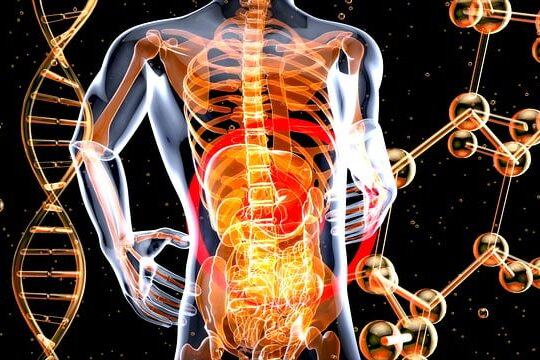Abstract
The prevalence of metabolic diseases, including obesity, dyslipidemia, type 2 diabetes mellitus (T2DM), and non-alcoholic fatty liver disease (NAFLD), is a severe burden in human society owing to the ensuing high morbidity and mortality.
Various factors linked to metabolic disorders, particularly environmental factors (such as diet and gut microbiota) and epigenetic modifications, contribute to the progression of metabolic diseases.
Dietary components and habits regulate alterations in gut microbiota; in turn, microbiota-derived metabolites, such as short-chain fatty acids (SCFAs), are influenced by diet. Interestingly, diet-derived microbial metabolites appear to produce substrates and enzymatic regulators for epigenetic modifications (such as DNA methylation, histone modifications, and non-coding RNA expression).
Epigenetic changes mediated by microbial metabolites participate in metabolic disorders via alterations in intestinal permeability, immune responses, inflammatory reactions, and insulin resistance.
In addition, microbial metabolites can trigger inflammatory immune responses and microbiota dysbiosis by directly binding to G-protein-coupled receptors (GPCRs). Hence, diet-gut microbiota-epigenetics may play a role in metabolic diseases.
However, their complex relationships with metabolic diseases remain largely unknown and require further investigation. This review aimed to elaborate on the interactions among diet, gut microbiota, and epigenetics to uncover the mechanisms and therapeutics of metabolic diseases.
1. Introduction
Metabolic diseases are public health problems worldwide [1]. Environment, lifestyle, and epigenetics contribute to the development of metabolic diseases [2], however, the complex interactions among these factors are unclear. Trillions of microorganisms exist in the host, especially obligate anaerobic organisms, which live in the intestinal lumen and participate in forming complex microbial communities, namely the gut microbiota [3]. The human gut is a bioreactor and a complex microbial ecosystem consisting of bacteria, archaea, and eukaryotes [4]. Gut microbiomes greatly influence host physiology and pathology, thereby regulating biological processes and the host’s health [5]. The disruption of the healthy balance of gut microbes contributes to the development of various chronic diseases and potentially inflammatory conditions [6]. The extent of the variations in the structure and function of gut microbiota in various studies is inconsistent and may be highly dependent on diet, especially the Western diet (rich in various fats and simple sugars) [5]. Additionally, dietary ingredients, dietary patterns and habits, even early in life, mediate changes in gut microbiome composition that contribute to the development of metabolic disorders [7].
Gut microbiota represents a host environment and is also considered as “the second genome” [8]. Compared with other sites of human body, the human gut microbiome approximately contains ~500–1000 bacterial species with an estimated 2,000,000 genes, which outnumbers the number of human different coding genes by 100 times [9]. Several mechanisms that associated pathophysiology with specific microbial metabolites isolate from the normal microbiome or gained by the disease associated microbiome have been identified [10], [11], [12]. It is widely known that the microbiome is the collective genomic information contained within the microbiota, and varies among apparently healthy people, changes with the effects of age, diet and lifestyle [13]. Some intrinsic factors such as intestinal permeability, pH, and mucus may determine the microbial composition and abundance. Other extrinsic factors including antibiotics [14], analgesics [15], psychotherapeutics [16] and dietary components [17] also occupy the same important position. In healthy conditions, the gut microbiota exhibits stability, resilience, and symbiotic interaction with the host. Given different kinds of factors that influence the microbiota, the composition and definition of a healthy microbiome remains a challenge [18]. Nowadays, the prevailing view is that a healthy microbiota community often represents high taxonomic diversity and microbial gene richness, and stable core microbiota [19]. With the rapid development of new technologies such as high-throughput sequencing, more attention has been paid on the relationship between microbiome functions.
Epigenetics includes DNA methylation, histone modifications, non-coding RNA (ncRNA) regulation, and chromosomal remodeling [20]. Epigenetic modifications are easily influenced by diet and the environment and can modulate gene expression; thus, epigenetics is considered a potentially critical mechanism of metabolic diseases [21]. Furthermore, epigenetic regulation is a key mechanism that influences host intestinal homeostasis and the development of metabolic disorders [22]. The food ingested by the host is fermented by the gut microbiota to produce metabolites. Microbiota-derived metabolites serve as substrates, regulate the activities of epigenetic modification enzymes, influence the expression of host genes, and trigger immune inflammation in intestinal epithelial cells (IECs), resulting in several metabolic disorders [23]. In addition, the gut microbiota is associated with host epigenetic profiling [24]. At present, various epigenetic drugs [25], histone deacetylase (HDAC) inhibitors [26], dietary supplements [27], probiotics [28], prebiotics [29] and fecal bacteria transplantation (FMT) [30] are developed rapidly. Hence, the interplay of diet-gut microbiota-epigenetics has become an attractive field of research to understand the etiology of metabolic diseases and identify novel strategies to combat this global epidemic.
To follow the artcle visit the link: https://www.sciencedirect.com/science/article/pii/S0753332222006795?via%3Dihub
Authors: Dan Li, Yujuan Li, Shengjie Yang, Jing Lu, Xiao Jin, Min Wu
Source: Science Direct






